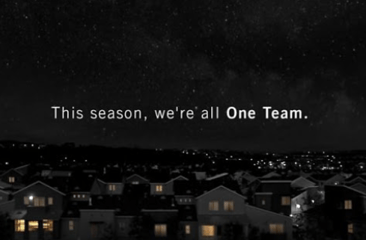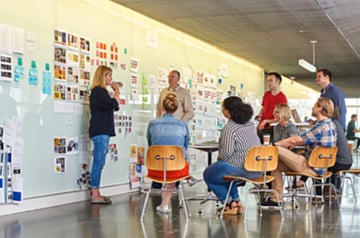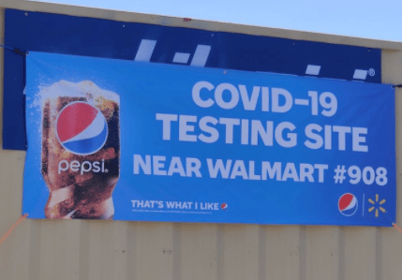Advertising's agile new normal
May 28, 2020

Just a couple weeks after the COVID-19 lockdown began, Budweiser released a commercial called “One Team” that celebrated everyone working to fight the still emerging pandemic. The sentiment was perfect for the moment, with the brand following many of the messaging guidelines we at Slingshot have recommended to our own clients.
But what was perhaps most remarkable about the endeavor is that it took just seven days to produce, from start to finish. And that was with every member of the brand, agency, and production teams working from home, in many different corners of the world. That’s quite a feat, especially when you consider the many months it typically takes major beer brands to turn creative work around.

This time, however, was different. Bud saw an opportunity to be front and center with a timely, relevant message. But it meant pivoting away from the spring sports sponsorships they’d typically be focused on, and they had to do so immediately. You can learn more about how they did it here.
At Slingshot, we were big believers in this way of thinking long before the COVID-19 lockdown. In fact, it’s why we developed our proprietary Agile Creative process, which we’ve used many times in recent years to help brands get great ideas to market faster.
Agility is one of the most potent yet overlooked weapons marketers have. It helps us stay fresh and relevant. It allows us to take advantage of changing conditions in the marketplace. And since so few marketers seem willing to embrace it, agility is also a great way to keep ahead of the competition.
We believe that as the country continues to reopen, the ability to stay nimble will be more important than ever. So, just what does being “agile” really mean? Here are five keys to agile marketing in the new normal.
Agile means pulling back the curtain.
Forget about concepting and developing ideas the traditional way. If you want to move fast, you have to bring more openness and collaboration into the process. Rather than formal presentations of fully-baked campaigns with every last tactic executed, connect sooner over ideas that are still just that: ideas.

Fill a wall or an entire room with inspiring thought starters– color palettes, photographic styles, typography, phrases, textures, quotes, songs, and so on. Anything that feels right for the brand in the moment. Then invite the whole team in to explore. This is not a “less is more” moment, nor the time to kill ideas. It’s a time to let everyone involved seek inspiration and articulate what they feel is right for the brand right now. It’s a time to say “what if.” Use this moment to focus creative energy in the right places, which will in turn lead to faster development with greater buy-in from the whole team.
Agile means creating more with less.
When Slingshot wanted to create a video celebrating our wonderful clients at Guaranty Bank, we weren’t going to let a little thing like a pandemic lockdown get in our way. Instead, we worked with the tools (and on-camera talent) we had at our disposal. And we couldn’t be prouder of the results.
It's the same approach we've taken to keep the creative fires burning for clients like Port Aransas Tourism, as we discussed here. Other brands have made good use of “new normal” as a similar jumping off point for creative executions. Microsoft and Progressive are two that have produced entire spots using video conference platform footage to great effect.
Just about every brand out there has been forced to improvise lately. And like any good improv artist knows, that can lead to great things, because a big idea is often at its best when expressed simply.
Can it be done just as well with a single camera shot as it might be with multiple shots in multiple locations? Does it need to be shot on an expensive camera at all? Could you use a type treatment to say the same thing that a high-dollar voice talent might? The simpler you keep the execution of the idea, the more energy you can put into the expression of it. And that can lead to unexpected outcomes. In the new normal, being agile will mean treating “less” as a strength, not as a weakness.
Agile means harnessing technology to create better connections.
Technology surrounds every brand out there. And yet many of those brands are only scratching the surface for how to get the most out of their own tech investments. From CRM platforms barely used, to automated customer service solutions only partially deployed– the list goes on and on. All of which leads to great untapped potential for more and better connections.
Presidents aren’t the only people who can make effective use of social media for reaching mass audiences in an instant. As our digital lives continue to accelerate, so too will the need for brands to meet consumer expectations for up-to-the-minute information. In this way, we’re seeing the line between traditional branding and direct customer communications continue to blur.
From product usage information on Pinterest to limited time offers blasted out to a waiting SMS audience, the messaging that brands put out “in the moment” will be just as important as communications crafted for the long haul.
Agile means finding new ways to use existing assets.
Not only has Budweiser demonstrated an agile approach to production, they’ve also exploited the value of existing assets. Two of their all-time most popular campaigns, “Whazzup” and “Real Men of Genius,” have both been given new life through retooled messages that are spot-on for the current cultural mood.
This is nothing new. GEICO has for years turned the reuse of vintage creative into opportunities to build new connections with consumers. And just like Bud, they look for news ways to showcase their old material, in GEICO’s case by wrapping it into promotions that let people choose their favorite classic spots. Point being, it’s not enough to simply run an old ad. The idea is to repurpose it, taking something that people already know and love and giving it all new life.
Agile means constant observation and assessment.
In a page ripped from the tech world playbook, the most agile brands know that sometimes the best first move is to simply watch and learn. See how people and other brands are behaving in the moment, good, bad, or otherwise. For example, we learned quickly from Pepsi that sponsoring COVID testing sites might not be such a hot idea.

To Pepsi’s credit, they were nimble enough to respond appropriately to the negative reaction, quickly pulling the messaging and openly responding to criticism.
When a brand is moving fast, it’s important to make sure to stay focused on the moment they’re living in. They can learn a lot from both the smart and not-so-smart moves of others. And should they make a mistake of their own, staying agile will allow them to correct it fast.
Even when the COVID crisis goes away, the importance of agility will still be here. In fact, from our perspective, it always has been. The current situation has merely helped shine a light on how crucial it is that a brand stay nimble and ready to respond to any unfolding situation. Agility, we believe, will continue to play a key role in keeping a brand relevant and achieving growth no matter the conditions.
See more marketing insights below on how to navigate your brand through the COVID-19 Crisis:





